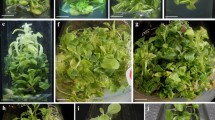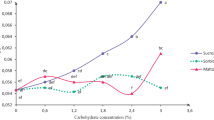Abstract
Calli were obtained from Ginkgo biloba embryos grown on Murashige and Skoog (MS) medium. The G. biloba cells could grow on either MS or Gamborg B5 mineral salt medium supplemented with sucrose (3% and 2%, respectively) and naphthaleneacetic acid (NAA) and kinetin (K) in concentrations ranging from 0.1 to 2.0 mg·L−1. Best growth and maintenance of callus cultures were achieved using MS medium supplemented with 2 mg·L−1 NAA and 1 mg·L−1 K (N2K1MS). Light was required to maintain healthy growth of the callus tissue.
In both MS and B5 based media, sucrose was hydrolyzed extracellularly before being taken up by Ginkgo cell suspension cultures. Specific growth rates of 0.13 d−1 and 0.08 d−1 were obtained in MS medium supplemented with 1 mg·L−1 NAA, 0.1 mg·L−1 K and 30 g·L−1 sucrose (N1K0.1MS) and B5 medium supplemented with the same growth regulator regime and 20 g·L−1 sucrose (N1K0.1B5) respectively. Complete phosphate and ammonium uptake was observed in 11 days when cultured in MS medium and 10 days and 4 days respectively when cultured in B5 medium. During the culture, G. biloba cells consumed only 64% and 29% of the nitrate content of N1K0.1MS and N1K0.1B5 media respectively. Maximum dry biomass concentrations were 13.4 g·L−1 and 7.9 g·L−1, and yields on carbohydrate were 0.39 and 0.45 in N1K0.1MS and N1K0.1B5 media respectively. The better performance of MS cultures came from the higher sucrose and nitrogen salts concentrations of this medium.
Similar content being viewed by others
Abbreviations
- B5:
-
Gamborg mineral salt medium
- d.w.:
-
Dry weight
- K:
-
Kinetin
- MS:
-
Murashige and Skoog mineral salt medium
- N or NAA:
-
Naphthaleneacetic acid
- NiKjMS:
-
i and j are the respective concentrations (mg·L−1) of NAA and K
- n:
-
Number of experimental points
- r:
-
Linear regression correlation coefficient
References
Beck E and Renner U “Ammonium triggers uptake of NO −3 by Chenopodium rubrum suspension culture cells and remobilization of their vacuolar nitrate pool” Plant Cell Physiol., 30, 487–495 (1989).
Drieu K (1986), “Préparation et définition de l'extrait de Ginkgo biloba”, La Presse médicale, 15, 1455–1457.
Gamborg L, Miller R, Ojima K (1968), “Nutrient requirements of suspension cultures of Soybean root cells”, Exp. Cell. Res., 50, 151–158.
Hahlbrock, K (1974) “Correlation between nitrate uptake, growth and changes in metabolic activities of cultured plant cells”. in Street H.E. (ed), Tissue Culture and Plant Science, Academic Press, pp. 363–377.
Mirashige T and Skoog F (1962), “A revised medium for rapid growth and bioassays with tobacco tissue cultures”, Physiol. Plant., 15, 473–497.
Standard Methods for the Examination of Water and Wastewater APHA-AWWA-WPCF (1985) 16th edition, 437–438.
Tulecke W and Nickell L (1959), “Production of large amounts of plant tissue by submerged culture”, Science, 130, 863–864.
Tulecke W (1960), “Arginine requiring strains of tissue obtained from Ginkgo pollen”, Plant Physiol., 35, 19–24.
Tulecke W, Weinstein L, Rutner A, Laurencot H (1962), “Biochemical and physiological studies of tissue cultures and the plant parts from which they were derived. II-Ginkgo bildoa”, Contributions from the Boyce Thompson Institute, 21, 292–301.
Tulecke W (1964), “A haploid tissue culture from the female gametophyte of Ginkgo biloba”, Nature, 203, 94–95.
Tulecke W and Rutner A (1965), “Changes in the amino acid composition of medium and cells of a plant tissue culture during growth in a liquid medium containing arginine”, in White and Grove (eds) Proceedings Int. Conf. Plant tissue culture, pp 103–116.
Tulecke W (1967), “Plasmid function in plant tissue cultures. I-Porphyrin synthesis by dark grown haploid and diploid albino cultures”, Amer. J. Bot., 54, 797–804.
Webb D, Arias W, De Hostos E (1986), “Callus formation by Ginkgo biloba embryos on hormone free media controlled by closures and media components”, Phytomorph., 36, 121–127.
Yates W (1986), “Induction of embryogenesis in embryo-derived callus of Ginkgo biloba”, VI Inter. Congr. Plant Tissue Cell Cult., University of Minnesota p. 43.
Author information
Authors and Affiliations
Additional information
Communicated by J.M. Widholm
Rights and permissions
About this article
Cite this article
Carrier, DJ., Cosentino, G., Neufeld, R. et al. Nutritional and hormonal requirements of Ginkgo biloba embryo-derived callus and suspension cell culture. Plant Cell Reports 8, 635–638 (1990). https://doi.org/10.1007/BF00269981
Received:
Revised:
Issue Date:
DOI: https://doi.org/10.1007/BF00269981




